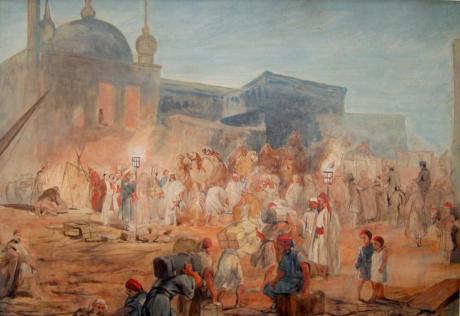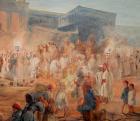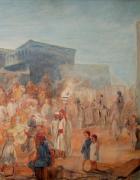indistinctly signed
This watercolour relates to Simpsons travels in Abyssinia . Th watercolour depicts a scene of embarkation and disembarkation at the Wharf of Port Faud (now part of Port Said.), showing European travellers amongst Egyptians. The Autobiography of William Simpson R.I. (Published by T. Fisher Unwin 1903) describes (at page 184 to 186) Simpson's travels in 1868 to join General Napier's expedition to Abyssinia to rescue the hostages being held by Emperor Teodorus. He travelled to Alexandria and then on to Suez where he hoped to catch a ship to Zoula (Annesley Bay) on the Red Sea coast to link up with Napier's expedtion. At Suez (ie. Port Said): "... I had some uncertainty as to whether I should reach Zoula ... from Suez or from Aden sooner. I thought I could discover this at Suez, but on arriving at the station there the passengers were informed that they would only be allowed fifteen minutes at the hotel. That seemed to me a mauvais quart d'heure. How was I to find out in fifteen minutes which plan to follow - to wait in Suez or go on with the steamer to Aden? If there were no steamers to Zoula from Suez and I missed the one just about to sail, I should lose a week of precious time. I made for the hotel in hopes that some one there could give me the necessary information. As I pushed along, I noticed an Arab with some luggage on his back, and my eye caught the word "Abyssinia" upon it. I noticed what I took to be the owner of the property walking before the Arab. I explained who I was, and the fix I was in for the moment, so he said, "Wait here, there is a transport sailing for Zoula on Monday (this was on Saturday), and I am going with her." What a relief this was to my anxious mind! It is at such moments that the special correspondent is tried, and it is often merely a question of turning to the right or to the left. Here it was, Shall I go on or wait? But it is on such slight chances that the seeing events or missing them depends. "My new friend turned out to be Captain Arbuthnot, of Sir Robert Napier's staff. He had been to Egypt about mules, that animal having assumed a great importance in connection with the transport department in Abyssinia." Simpson had two days to kill at Port Said while he waited for the boat to Zoula, and it is possible that he took the opportunity to sketch the activities in the port area while he waited.
Born into poverty in Glasgow, Simpson went on to become one of the leading 'special artists' of his day, and sketched many scenes of war for the Illustrated London News. His early years were very difficult living in a house with an abusive and alcoholic father, and in 1834 he was sent to live with his grandmother in Perth. Simpson's only formal schooling took place during this period and within a few years, he was working as an apprentice in the Glasgow lithographic firm of Macfarlane. The artist stated later that "this was the turning point which changed all my boyish intentions." It was during the years in Glasgow that he attended the Andersonian University and the Mechanics Institute in the evenings. His next position was to create an image of the Alma based on various accounts so that it could be lithographed by another London publisher, Lloyd's. He also put sketches sent from the Baltic onto stone for the firm of Colnaghi. In anticipation of the fall of Sebastopol, Lloyd's had him prepare an image of the fall of the town so that it could be published immediately upon news of its actual capture. This presented a challenge to Simpson as he had little information about Sebastopol. He occasionally spoke with Mr. Day of Day and Son about the need to have sketches drawn at the front. Shortly thereafter, Colnaghi's contacted Simpson and invited him to go out to the Crimea and make sketches for the company. In the late 1850s he was sent to India to sketch scenes relating to the recent Sepoy Revolt. The idea was to produce an illustrated publication similar to the Crimean portfolio, and Simpson had discussed the possibility with Mr. Day. The artist arrived at Calcutta on 29 October 1859, and traveled in Punjab, Sutlej, Bengal, Lucknow and Cawnpore, central India, the Himalayas, Kashmir and Madras. In February, 1862, he left Bombay and arrived in London only to find that Day and Son could not afford to produce a portfolio. Nevertheless, a large volume of colored lithographs was published under the title India Ancient and Modern. He was commissioned by Day & Son to visit these parts of India and record the places affected by the momentous events of the 'Mutiny' of 1857. Before leaving, he spent 'a considerable time in the library of the India House, then in Leadenhall Street, looking over books about India, such as Daniels', to see what had been already done, and to get hints as to places I ought to visit'. The set of lithographs produced, based on his watercolours, was intended to rival David Roberts' Holy Land in scope. However, the project never came to fruition. This was caused by the financial collapse of Day & Son, due to the rise of wood engraving. By 1866, Simpson had delivered 250 watercolours to Day & Son and these were subsequently sold off as bankrupt stock.[1] Only 50 had been prepared as chromolithographs, and were published in 1867 as India ancient and modern. A series of illustrations of the country and people of India and adjacent territories. For Simpson this was little consolation: 'So the great work on India, on which I had bestowed so much time and labour, never came into existence...'In 1866, Simpson was contacted by the Illustrated London News to do some sketches of the Prince of Wales, on a visit to the Duke of Sutherland at Dunrobin Castle. Afterwards, the paper asked him to go to St. Petersburg and cover the Prince of Wales's attendance at the marriage of the Czarevich, afterward Emperor Alexander III.Two years later, Simpson was out in Abyssinia covering the campaign that had broken out. Initially, the paper used sketches supplied by one of the soldiers on campaign, Colonel Baigrie, but as his pictures were most landscapes, the paper felt that Simpson could add more life to the accounts of the war. The artist arrived at Suez on 18 June 1868, but by the time he neared the front, news came that Magdala had fallen to the Anglo-Indian force. Nonetheless, he was able to observe the retreat of the Abyssinian army, and the remains of the royal quarters of Emperor Theodore at Magdala. He arrived back at Dover on 2 July 1868 and the Illustrated London News published a special folio volume on the Abyssinian Campaign containing many of Simpson's and Baigrie's drawings. On 15 October 1878, Simpson left London en route to Afghanistan to provide illustrations of the Afghan war that had broken out. Traveling via Lahore and Peshawar, he passed through the Khyber Pass and witnessed the 'first shot' fired at Ali Masjid. He became friendly with Sir Louis Cavagnari and the latter encouraged Simpson with his explorations of ancient Buddhist stupas in and around the Jalalabad Valley. While the Peshawar Valley Field Force was encamped at Jalalabad and later Gandamak, Simpson was allowed to have some soldiers to help him excavate Ahin Posh Tope and several other sites. On one occasion, he was shot at by an Afghan but the bullet just missed. At Gandamak, he met the photographer John Burke and his counterpart at The Graphic, Frederic Villiers, and after the departure of Archibald Forbes, Simpson took over the task of supplying the Daily News with accounts of the campaign. In May 1879, he observed the signing of a peace treaty at Gandamak which ended the war for the time being. When it was decided to send a mission to Kabul, Simpson applied to go but was turned down. His primary interest in accompanying the mission was to visit the giant Buddhas at Bamyan, but had he gone to Kabul, he probably would have been killed liked the rest of the mission. It was this event which precipitated the second part of the war including the disaster at Maiwand.Simpson returned to London in the summer of 1879. Upon his arrival, he visited the offices of the Illustrated London News on the Strand and collected all his sketches and water-colors which he proceeded to mount in two large albums. He also presented several papers to various learned societies on such aspects as Buddhist prayer wheels, sculptured topes and ancient remains in the Jalalabad Valley. In the same year he was elected a full member of the Institute of Painters in Water Colours.Throughout the following decade, Simpson continued his travels on behalf of his newspaper covering such events as royal weddings and coronations. In 1890, he observed the opening of the Forth Bridge and caught a chill which was to have detrimental effects on his health.



